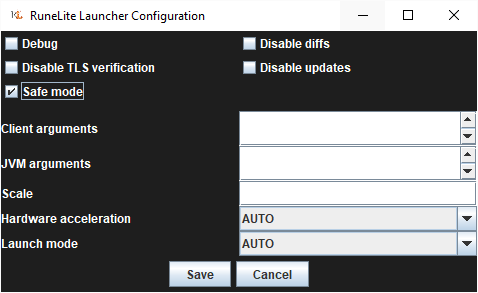RuneLite Launcher Configuration
The RuneLite Launcher Configuration window was added in launcher version 2.6.3, released March 5, 2023. To update your launcher please visit the RuneLite website and select to download the setup file for your Operating System then install the launcher using that.
The Configure window can be then opened by selecting the RuneLite (configure) start menu entry, on Windows, or if using Mac/Linux by passing the command line argument --configure to the launcher (e.g. on mac, run /Applications/RuneLite.app/Contents/MacOS/RuneLite --configure in Terminal).


The Configuration Window allows all launcher and client arguments to be configured and saved for use on any subsequent launch. The configuration is also saved in such a way that when launching RuneLite through the Jagex Launcher they are also applied.
- Debug
- Disable TLS verification
- Safe mode
- Disable diffs
- Disable updates
- Client arguments
- JVM arguments
- Scale
- Hardware acceleration
- Launch mode
Runs the launcher and client in debug mode. Debug mode writes debug level logging to the log files.
cli: --debug
Downloads full artifacts for updates instead of diffs.
cli: --nodiff
Disables TLS verification.
cli: --insecure-skip-tls-verification
Disables the launcher self updating.
cli: --noupdate
Launches the client in safe mode. This disables loading of plugins installed from the Plugin-Hub and disables the core GPU plugin.
cli: --safe-mode
Optional arguments passed to the client. One per line.
A popular client argument being profile to load a specific settings profile on launch.
The profile arg can be supplied with a profile name such as --profile=ironman to load on client launch the settings profile named "ironman".
cli: --profile=<profile_name>
Optional arguments passed to the JVM. One per line.
This is commonly used to increase the max heap size (the memory limit). This can be done via the -Xmx option, for example use -Xmx1536M to double the clients available heap size. Some 3rd party plugins use an unbounded amount of memory, and increasing the max heap size only increases the time until the client crashes. In this case, you will likely need to remove the bad plugin(s).
Scaling factor for Java 2D. For use overriding scaling performed by your Operating System.
Values passed should be in the format of #.#, 1.0 for no scaling, 2.0 for scaled up to double size, 0.5 for scaling down to half size, and such.
cli: --scale=<VALUE>
Hardware acceleration mode for Java 2D.
- AUTO - lets the launcher set the mode to whatever is default for your operating system
- OFF (Linux default) - disables hardware acceleration
- DIRECTDRAW (Windows default) - enables Direct3D for hardware acceleration (Windows only)
- OPENGL (macOS default) - enables the OpenGL-based pipeline for hardware acceleration
- METAL - enables the Apple Metal API for hardware acceleration (macOS only)
cli: --mode=<OPTION>
- AUTO
- JVM
- FORK
- REFLECT
cli: --launch-mode=<OPTION>
Please join our Discord if you notice anything wrong or would like to discuss an addition to the wiki. Changes can be submitted to our wiki repository.
User Guide
- FAQ
- GPU FAQ
- RuneLite Launcher Configuration
- Verifying Launcher Authenticity
- Troubleshooting problems with the client
- Disable Hardware Acceleration
- Change DPI Scaling (Ubuntu 20 w/ Gnome)
- Information about the Plugin Hub
- General Features
-
Plugin Configuration
- Agility
- Ammo
- Animation Smoothing
- Anti Drag
- Attack Styles
- Bank
- Bank Tags
- Barbarian Assault
- Barrows Brothers
- Blast Furnace
- Blast Mine
- Boosts Information
- Boss Timers
- Camera
- Cannon
- Chambers of Xeric
- Chat Channels
- Chat Color
- Chat Commands
- Chat Filter
- Chat History
- Chat Notifications
- Chat Timestamps
- Clue Scroll
- Combat Level
- Cooking
- Corporeal Beast
- Custom Cursor
- Daily Task Indicator
- Default World
- Diary Requirements
- Discord
- DPS Counter
- Emojis
- Entity Hider
- Examine
- FPS Control
- Fairy Rings
- Fishing
- Friend List
- Friend Notes
- GPU
- Grand Exchange
- Ground Items
- Ground Markers
- Herbiboar
- HiScore
- Hunter
- Idle Notifier
- Implings
- Info Panel
- Instance Map
- Interface Styles
- Inventory Grid
- Inventory Tags
- Inventory Viewer
- Item Charges
- Item Identification
- Item Prices
- Item Stats
- Key Remapping
- Kingdom of Miscellania
- Kourend Library
- Login Screen
- Loot Tracker
- Low Detail
- Mage Training Arena
- Menu Entry Swapper
- Metronome
- Minimap
- Mining
- Motherlode Mine
- Mouse Tooltips
- Music
- NPC Aggression Timer
- NPC Indicators
- Nightmare Zone
- Notes
- Object Markers
- Opponent Information
- Party
- Pest Control
- Player Indicators
- Player-owned House
- Poison
- Prayer
- Puzzle Solver
- Pyramid Plunder
- Quest List
- Random Events
- Regeneration Meter
- Report Button
- Run Energy
- Rune Pouch
- RuneLite
- Runecraft
- Screen Markers
- Screenshot
- Skill Calculator
- Skybox
- Slayer
- Smelting
- Special Attack Counter
- Status Bars
- Stretched Mode
- Team Capes
- Tears Of Guthix
- Tile Indicators
- Time Tracking
- Timers
- Tithe Farm
- Twitch
- Virtual Levels
- Wiki
- Wintertodt
- Woodcutting
- World Hopper
- World Map
- XP Drop
- XP Globes
- XP Tracker
- XP Updater
- Zalcano
Developer's Guide
- Plugin Development
- RuneLite Core Development
- Using Git with RuneLite
- Using Jagex Accounts
- Working with client scripts
- Using the client developer tools
- VarPlayers, VarBits, and VarClients
- Rejected or Rolled Back Features